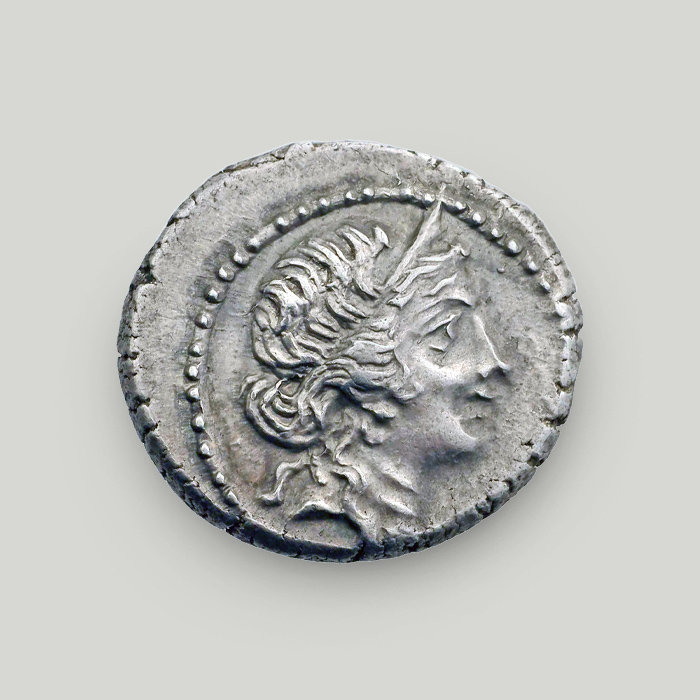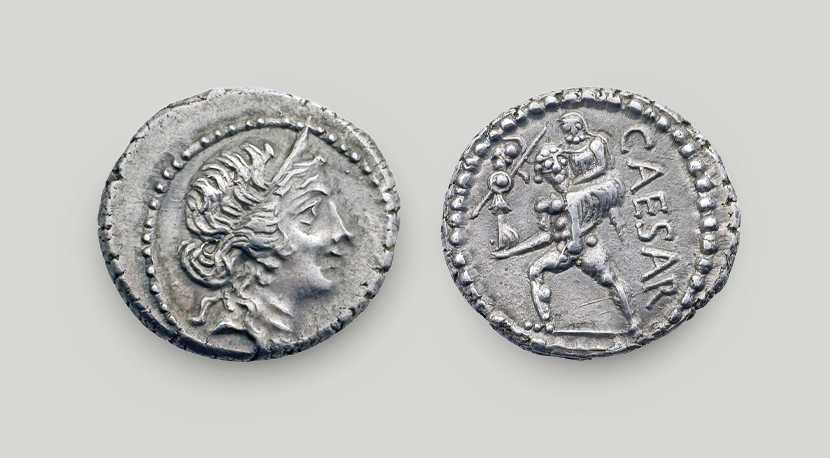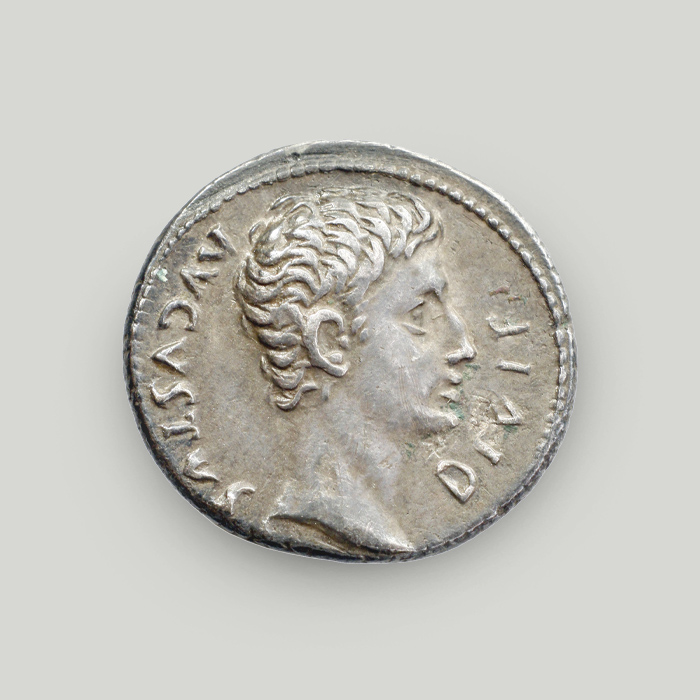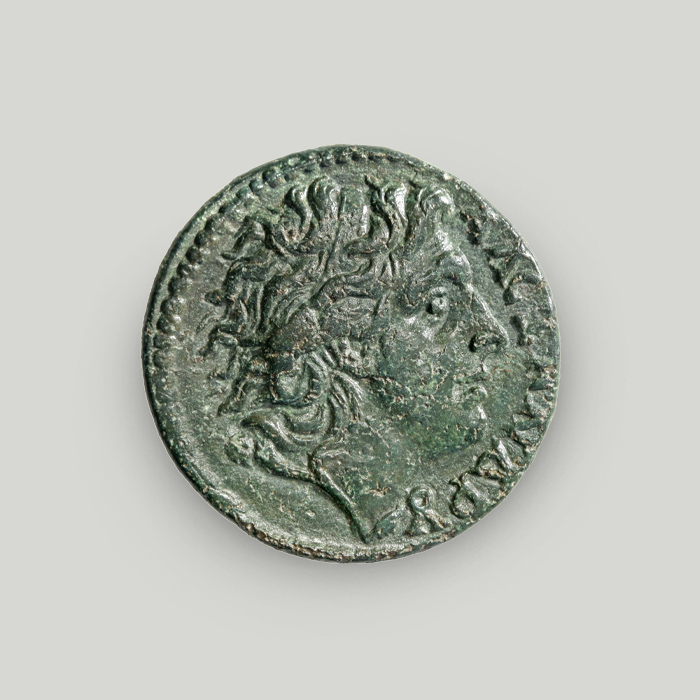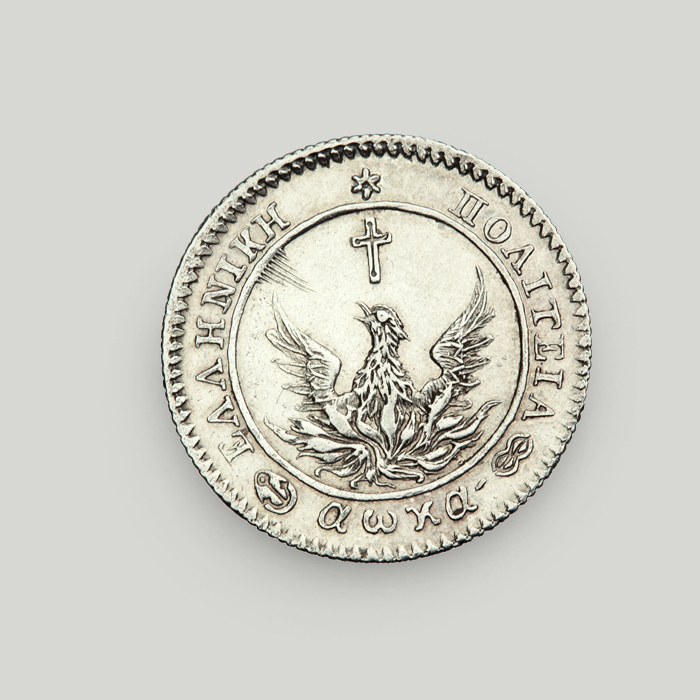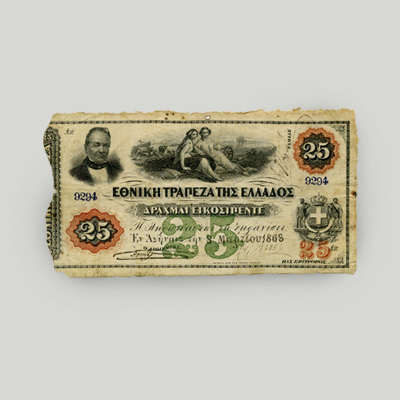Silver denarius of Julius Caesar
Julius Caesar was instrumental in transforming the Roman Republic to the Roman Empire. In 47-46 BCE he minted a silver denarius with one of the most beautiful coin types: the depiction of a son’s love towards his father. In a famous scene from the Iliad, Aeneas is depicted carrying his old father Anchises on his shoulders as they flee Troy.
Obverse
Head of Aphrodite in profile facing right, within a circular dotted border.
Reverse
Aeneas carrying his old father Anchises on his shoulders. He holds the Palladium, the wooden cult statue of Pallas Athena, in his right hand. The legend on the right reads “CAESAR”. The entire type is enclosed in a circular dotted border.
Julius Caesar
Gaius Julius Caesar (100-44 BCE) was a Roman politician, general and author. He was instrumental in transforming the Roman Republic to the Roman Empire.
However, he did not end his days in peace. On 15 March 44 BCE, Brutus assassinated him in the Roman Senate. Brutus was a Roman politician previously close to Julius Caesar. The latter actually considered him his biological son.
Minting under Julius Caesar
The coinage minted under Julius Caesar depicts some of the most beautiful ancient mythical themes. At the same time, Caesar’s coins were a means for him to assert his superiority.
In 49 BCE Julius Caesar had coins issued with his name on them. The coins also bore his titles, as well as the political and religious offices he held. This practice contributes to our understanding of his ascension to power.
During the same period, he issued coins that contained religious, military and political symbolism to further underline his absolute power.
Months before his assassination, Julius Caesar did something unheard of in Roman coinage until then. He issued coins bearing his likeness. This was the first time in Roman history that a living person was depicted on coinage. His successors later adopted this practice.
A Roman trademark
The denarius became the standard of the Roman monetary system for 5 centuries.
Its main fraction was called sestertius (1 denarius = 4 sestertii), initially minted in silver, then in bronze. There were, of course, other denominations.
The denarius today
In modern Romance languages, the words for “money” are etymologically connected to the denarius, e.g. denaro in Italian, dinheiro in Portuguese etc.
The modern dinar is also the currency of many countries, such as Serbia, North Macedonia and some countries in the Arab world.
Enjoying the protection of Aphrodite
Throughout his military and political career, Julius Caesar claimed to enjoy special protection and aid from the goddess Aphrodite. During his uncle’s funeral in 69 BCE, he went as far as publicly announcing his family’s affiliation with the goddess and claiming to be descended from her son Aeneas.
Around 47-46 BCE Julius Caesar issued the second most important series of coins in his career, namely the silver denarius. This was his way of establishing and commemorating his divine descent and thanking Aphrodite for her precious aid in the battle against Pompey.
Aeneas and the origins of the Roman people
Despite being second in command in the Trojan army under Hector, Aeneas was given a prominent place in Roman history as founder of the Roman race.
To commemorate the origins of the Romans, Julius Caesar decided that the silver denarius should depict the famous scene from the Iliad where Aeneas carries his old father on his shoulders as they flee Troy. It is one of the most touching stories of filial love ever to decorate a coin.
The silver denarius provides one more interesting piece of information. Aeneas holds in his right hand the Palladium, the wooden cult statue of Pallas Athena that fell from the sky and protected the city of Troy.
Even though it is not clear who actually took the Palladium away from Troy, some believe it was Aeneas. Aeneas was familiar with a myth according to which the Palladium would also protect the new city to be founded by the fleeing Trojans, namely Rome.
The myth of Aeneas
Anchises, son of Capys and Themiste, was one of Aphrodite’s greatest mortal loves. He was a very charming prince, and the goddess fell passionately in love with him. The mythical Trojan hero Aeneas was the fruit of their union.
According to the Roman poet Virgil in his epic Aeneid, Anchises found himself at a loss when the Greeks conquered Troy after a 10-year siege. He was an 80-year-old invalid and would be unable to flee. Without thinking twice, Aeneas carried his father on his shoulders and led him to safety.
The Greeks marvelled at this selfless deed and let Aeneas return to his home, free to take anything he needed. The old man Anchises then followed his son when he headed to Italy. He provided his wise counsel and guidance throughout Aeneas’ wanderings.
After fleeing Troy, Aeneas made landfall at Carthage and Sicily before finally settling in Italy. There, according to one of several traditions, his grandchildren became the founders of Rome.
The Alpha Bank Numismatic Collection is not open to the public.
Research visits to the Numismatic Collection can be organised upon request.
Contact us to book your visit.
